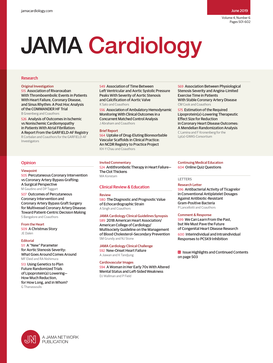Contemporary Incidence and Procedural Volume of Transcatheter Aortic Valve Reintervention.
IF 14.1
1区 医学
Q1 CARDIAC & CARDIOVASCULAR SYSTEMS
引用次数: 0
Abstract
Importance Transcatheter aortic valve replacement (TAVR) reintervention is performed by either redo TAVR or TAVR explant. There is insufficient data on contemporary TAVR reintervention procedural incidence and volume. Objective To evaluate contemporary procedural volumes of redo TAVR and TAVR explant. Design, Setting, and Participants This retrospective analysis of redo TAVR and TAVR explant annual incidence and procedural volume was performed from January 2012 to June 2024. For comprehensive assessment of aortic valve replacement, analysis of SAVR reintervention annual incidence and procedural volume was also performed. Data were obtained through the US Centers for Medicare & Medicaid Services Virtual Research Data Center. Patients with prior TAVR or SAVR who underwent subsequent TAVR or SAVR were included. Exposures Patients who underwent a TAVR after TAVR defined the redo TAVR group, while patients who underwent SAVR after TAVR defined the TAVR explant group. Patients who underwent a TAVR after SAVR defined the valve-in-valve (ViV) TAVR group, while patients who underwent SAVR after SAVR defined the redo SAVR group. Analysis of annual incidences and procedural volumes of all groups at different time intervals was conducted. Main Outcomes and Measures The primary outcome was annual incidence and procedural volume of both redo TAVR and TAVR explant. The secondary outcome was annual incidence and procedural volume of both ViV TAVR and redo SAVR. Results Of 410 720 total TAVRs from 2012 to 2024, 2374 redo TAVRs and 1346 TAVR explants were identified. Of 299 780 total SAVRs from 2012 to 2024, 5044 ViV-TAVRs and 4202 redo SAVRs were identified. Since 2020, there have been 1518 redo TAVRs and 1007 TAVR explants. The annual incidence of TAVR reintervention has changed from 0.17% in 2019 to 0.28% in 2023. Although the most common time interval for redo TAVR after index TAVR was within 3 months (410 of 2374 [17.3%]) and for TAVR explant after index TAVR was 1 to 2 years (259 of 1346 [19.2%]), redo TAVR was the predominant procedure beyond 5 years from the index TAVR (725 of 819 [88.5%]). Conclusions and Relevance In this study, annual volumes of both redo TAVR and TAVR explant continued to increase, particularly in recent years. Redo TAVR is frequently performed over 5 years from the index TAVR. Future analysis to determine the appropriate TAVR reintervention strategy for individual patients is needed.当代经导管主动脉瓣再介入的发生率和手术量。
重要性经导管主动脉瓣置换术(TAVR)再介入可通过重做TAVR或TAVR外植体进行。关于当代TAVR再介入手术的发生率和数量的数据不足。目的评价当代重做TAVR和TAVR植体的手术容积。设计、环境和参与者本研究回顾性分析了2012年1月至2024年6月期间重做TAVR和TAVR外植体的年发病率和手术量。为了全面评估主动脉瓣置换术,还分析了每年SAVR再介入发生率和手术容积。数据通过美国医疗保险和医疗补助服务中心虚拟研究数据中心获得。既往有TAVR或SAVR的患者随后进行了TAVR或SAVR。TAVR后接受TAVR的患者定义为重做TAVR组,而TAVR后接受SAVR的患者定义为TAVR外植体组。SAVR后接受TAVR的患者定义为瓣中瓣膜(ViV) TAVR组,而SAVR后接受SAVR的患者定义为重做SAVR组。分析各组在不同时间间隔的年发病率和手术量。主要观察指标为TAVR和TAVR移植体的年发生率和手术体积。次要终点是ViV TAVR和redo SAVR的年发生率和手术体积。结果2012 - 2024年共检测到410 720个TAVR,其中重做TAVR 2374个,TAVR外植体1346个。在2012年至2024年共299 780个savr中,鉴定出5044个viv - tavr和4202个redo savr。自2020年以来,已有1518个重做TAVR和1007个TAVR外植体。TAVR再干预的年发生率从2019年的0.17%上升到2023年的0.28%。虽然指数TAVR术后重做TAVR最常见的时间间隔为3个月(2374例中有410例[17.3%]),指数TAVR术后外植体重做TAVR的时间间隔为1至2年(1346例中有259例[19.2%]),但指数TAVR术后5年以上重做TAVR是主要手术(819例中有725例[88.5%])。在本研究中,重做TAVR和TAVR外植体的年体积持续增加,特别是近年来。重做TAVR通常在从索引TAVR开始的5年内执行。需要进一步分析以确定适合个体患者的TAVR再干预策略。
本文章由计算机程序翻译,如有差异,请以英文原文为准。
求助全文
约1分钟内获得全文
求助全文
来源期刊

JAMA cardiology
Medicine-Cardiology and Cardiovascular Medicine
CiteScore
45.80
自引率
1.70%
发文量
264
期刊介绍:
JAMA Cardiology, an international peer-reviewed journal, serves as the premier publication for clinical investigators, clinicians, and trainees in cardiovascular medicine worldwide. As a member of the JAMA Network, it aligns with a consortium of peer-reviewed general medical and specialty publications.
Published online weekly, every Wednesday, and in 12 print/online issues annually, JAMA Cardiology attracts over 4.3 million annual article views and downloads. Research articles become freely accessible online 12 months post-publication without any author fees. Moreover, the online version is readily accessible to institutions in developing countries through the World Health Organization's HINARI program.
Positioned at the intersection of clinical investigation, actionable clinical science, and clinical practice, JAMA Cardiology prioritizes traditional and evolving cardiovascular medicine, alongside evidence-based health policy. It places particular emphasis on health equity, especially when grounded in original science, as a top editorial priority.
 求助内容:
求助内容: 应助结果提醒方式:
应助结果提醒方式:


